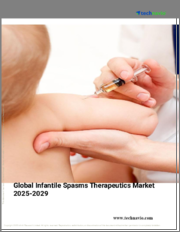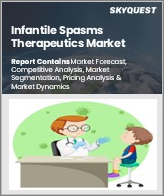
|
시장보고서
상품코드
1635875
영아 연축 치료 시장 : 치료 클래스별, 약물 유형별, 조제별, 투여 경로별, 유통 채널별, 최종사용자별, 지역별(2025-2033년)Infantile Spasms Therapeutics Market by Therapeutic Class, Drug Type (Vigabatrin, Adrenocorticotropic Hormone, and Others ), Dosage, Route of Administration, Distribution Channel, End User, and Region 2025-2033 |
||||||
영아 연축 치료 시장 세계 시장 규모는 2024년 38억 달러에 달했습니다. 향후 IMARC Group은 2033년까지 시장 규모가 52억 달러에 달할 것으로 예상하며, 2025-2033년 연평균 성장률(CAGR)은 3.52%에 달할 것으로 전망하고 있습니다. 영유아 경련 발작의 유병률 증가, 대중의 건강 인식 증가로 인한 조기 진단, 제품 승인 수 증가 및 강력한 파이프라인 의약품의 존재는 시장을 이끄는 주요 요인 중 일부입니다.
영아 연축 치료는 보통 생후 4개월에서 1세 사이의 영아에서 경련 발작 및 간질 증후군을 치료하는 치료법을 말합니다. 경련 증상은 갑자기 몸이 경직되고, 팔, 다리, 머리가 앞으로 구부러지고, 등이 굽어지며, 짧고 미묘한 발작이 일어나는 것이 특징입니다. 영아 연축은 뇌종양, 출생 시 손상, 뇌의 감염, 유전적 변화에 의해 유발될 수 있습니다. 영아 경련에는 스테로이드, 코르티코트로핀 주사제나 글루코코르티코이드를 이용한 호르몬 요법, 항경련제 등 다양한 치료법이 있습니다. 점두간질(허리증후군) 치료는 경련 발생 후 3주 이내에 시행해야 지속적인 효과를 얻을 수 있으며, 치료에는 단독요법과 병용요법이 있습니다. 영아 연축은 신체 진찰, 신경학적 진찰, 뇌 MRI, 혈액 검사, 소변 검사 등을 통해 진단합니다.
영아 연축 치료 시장 동향:
신생아에서 영아 연축의 유병률 증가는 시장 성장을 촉진하는 중요한 요인입니다. 이는 전 세계적으로 출산율이 크게 증가하고 있기 때문입니다. 이에 따라 제품 승인 건수의 증가와 강력한 파이프라인 의약품의 존재가 시장에 긍정적인 영향을 미치고 있습니다. 발작을 감지하여 보호자에게 경고하는 발작 경고 장치의 도입 등 영아 연축 치료의 지속적인 기술 발전이 시장에 활력을 불어넣고 있습니다. 또한, 조기 진단과 치료에 대한 인식이 확산되면서 영아 연축 치료의 보급률이 높아져 시장 성장을 견인하고 있습니다. 그러나 낮은 치료 성공률, 높은 치료 비용, 의약품 승인에 대한 엄격한 규제, 미진단 환자 증가 등 다양한 요인들이 영아 연축 치료 시장의 성장을 저해하고 있습니다. 반면, 이 질환에 대한 인식을 높이기 위해 여러 국가의 정부 및 민간 단체에서 시행하고 있는 여러 가지 긍정적인 노력과 프로그램들이 시장의 긍정적인 전망을 만들어내고 있습니다. 또한, 주요 기업들이 성공률이 높은 혁신적인 의약품 개발에 중점을 둔 광범위한 연구 개발(R&D) 활동을 전개하고 있는 것도 시장을 주도하고 있습니다. 이 밖에 의료비 증가, 공동연구, 제휴 및 인수합병(M&A) 증가, 급속한 도시화, 가처분 소득 수준 증가 등이 시장 성장에 기여하는 요인으로 꼽힙니다.
본 보고서에서 다루는 주요 질문
- 전 세계 영아 연축 치료 시장 규모는?
- 2025-2033년 세계 영아 연축 치료 시장의 예상 성장률은?
- 세계 영아 연축 치료 시장을 이끄는 주요 요인은 무엇인가?
- COVID-19가 전 세계 영아 연축 치료 시장에 미치는 영향은?
- 전 세계 영아 연축 치료 시장의 치료군별 분류는?
- 약물 유형에 따른 전 세계 영아 연축 치료 시장 현황은?
- 제제 기반 세계 영아 연축 치료 시장 현황은?
- 전 세계 영아 연축 치료 시장의 투여 경로별 시장 현황은?
- 전 세계 영아 연축 치료 시장 유통 채널별 현황은?
- 전 세계 영아 연축 치료 시장의 최종사용자별 분석은 어떻게 되는가?
- 전 세계 영아 연축 치료 시장의 주요 지역은?
- 세계 영아 연축 치료 시장의 주요 플레이어/기업은?
목차
제1장 서문
제2장 조사 범위와 조사 방법
- 조사 목적
- 이해관계자
- 데이터 소스
- 1차 정보
- 2차 정보
- 시장 추정
- 상향식 접근
- 하향식 접근
- 조사 방법
제3장 주요 요약
제4장 소개
- 개요
- 주요 업계 동향
제5장 세계의 영아 연축 치료 시장
- 시장 개요
- 시장 실적
- COVID-19의 영향
- 시장 예측
제6장 시장 내역 : 치료 클래스별
- 항경련제
- 시장 동향
- 시장 예측
- 코르티코스테로이드
- 시장 동향
- 시장 예측
- 기타
- 시장 동향
- 시장 예측
제7장 시장 내역 : 약물 유형별
- 비가바트린
- 시장 동향
- 시장 예측
- 부신피질 자극 호르몬
- 시장 동향
- 시장 예측
- 기타(단계 III)
- 시장 동향
- 시장 예측
제8장 시장 내역 : 조제별
- 고체
- 시장 동향
- 시장 예측
- 액체
- 시장 동향
- 시장 예측
제9장 시장 내역 : 투여 경로별
- 경구
- 시장 동향
- 시장 예측
- 비경구
- 시장 동향
- 시장 예측
- 기타
- 시장 동향
- 시장 예측
제10장 시장 내역 : 유통 채널별
- 병원 약국
- 시장 동향
- 시장 예측
- 소매 약국
- 시장 동향
- 시장 예측
- 온라인 약국
- 시장 동향
- 시장 예측
제11장 시장 내역 : 최종사용자별
- 병원
- 시장 동향
- 시장 예측
- 클리닉
- 시장 동향
- 시장 예측
- 기타
- 시장 동향
- 시장 예측
제12장 시장 내역 : 지역별
- 북미
- 미국
- 캐나다
- 아시아태평양
- 중국
- 일본
- 인도
- 한국
- 호주
- 인도네시아
- 기타
- 유럽
- 독일
- 프랑스
- 영국
- 이탈리아
- 스페인
- 러시아
- 기타
- 라틴아메리카
- 브라질
- 멕시코
- 기타
- 중동 및 아프리카
제13장 촉진요인, 억제요인, 기회
- 개요
- 성장 촉진요인
- 성장 억제요인
- 기회
제14장 밸류체인 분석
제15장 Porter's Five Forces 분석
- 개요
- 구매자의 교섭력
- 공급 기업의 교섭력
- 경쟁 정도
- 신규 참여업체의 위협
- 대체품의 위협
제16장 가격 분석
제17장 경쟁 구도
- 시장 구조
- 주요 기업
- 주요 기업 개요
- H. Lundbeck A/S
- Mallinckrodt plc
- ORPHELIA Pharma
- Teva Pharmaceuticals USA Inc.(Teva Pharmaceutical Industries Ltd.)
The global infantile spasms therapeutics market size reached USD 3.8 Billion in 2024. Looking forward, IMARC Group expects the market to reach USD 5.2 Billion by 2033, exhibiting a growth rate (CAGR) of 3.52% during 2025-2033. The rising prevalence of seizures in infants, increasing health consciousness among the masses resulting in early diagnosis, and the growing number of product approvals and presence of strong pipelines drugs represent some of the key factors driving the market.
Infantile spasms therapeutics refer to the treatment procedures used for treating seizures or an epilepsy syndrome in young children, usually aged between four months and a year of age. An episode of spasm is characterized by the body stiffening suddenly, arms, legs, and head bending forward, the back arching, and short, subtle seizures. Infantile spasm can be caused by brain tumors, birth injuries, infection of the brain, and genetic changes. There are a number of therapeutic options that are available for infantile spams, including steroids, hormone therapy with corticotropin injection gel and glucocorticoids, as well as antiseizure medications. Infantile spasms therapeutics are more likely to provide sustained results if they are implemented within three weeks after the spasms occur, and treatment can be done by monotherapy or combination therapy. Infantile spasms are diagnosed by physical examination, neurological examination, MRI of the brain, and blood and urine examinations.
Infantile Spasms Therapeutics Market Trends:
The increasing prevalence of infantile spasms among newborn babies is a significant factor driving the growth of the market. This can be attributed to a considerable rise in the birth rates across the globe. In line with this, the growing number of product approvals and presence of strong pipelines drugs are impacting the market positively. Continual technological advancements in the treatment of infantile spasms, such as the introduction of seizure alert device for detecting seizures and alerting the caregivers, are providing an impetus to the market. Also, the widespread awareness regarding early diagnosis and treatment is enhancing the penetration rate of infantile spasm drugs, thereby fueling the market growth. However, various factors, such as lesser treatment success rates, high cost of treatment, strict regulations for drug approval, and the augmenting undiagnosed patient pool, are impeding the growth of the infantile spasms therapeutics market. On the contrary, favorable initiatives and programs conducted by the government and private organizations of several countries for promoting awareness regarding the medical condition is creating a positive market outlook. The market is further driven by the extensive research and development (R&D) activities conducted by the key market players focusing on the development of innovative drugs with higher success rates. Some of the other factors contributing to the market include the expanding healthcare expenditure, rising number of collaborations, partnerships and merger and acquisitions (M&As), rapid urbanization, and inflating disposable income levels.
Key Market Segmentation:
Therapeutic Class Insights:
- Anticonvulsants
- Corticosteroids
- Others
Drug Type Insights:
- Vigabatrin
- Adrenocorticotropic Hormone
- Others (Phase III)
Dosage Insights:
- Solid
- Liquid
Route of Administration Insights:
- Oral
- Parenteral
- Others
Distribution Channel Insights:
- Hospital Pharmacy
- Retail Pharmacy
- Online Pharmacy
End User Insights:
- Hospitals
- Clinics
- Others
Regional Insights:
- North America
- United States
- Canada
- Asia Pacific
- China
- Japan
- India
- South Korea
- Australia
- Indonesia
- Others
- Europe
- Germany
- France
- United Kingdom
- Italy
- Spain
- Russia
- Others
- Latin America
- Brazil
- Mexico
- Others
- Middle East and Africa
- The report has also provided a comprehensive analysis of all the major regional markets that include North America (the United States and Canada); Asia Pacific (China, Japan, India, South Korea, Australia, Indonesia, and others); Europe (Germany, France, the United Kingdom, Italy, Spain, Russia, and others); Latin America (Brazil, Mexico, and others); and the Middle East and Africa. According to the report, North America was the largest market for infantile spasms therapeutics. Some of the factors driving the North America infantile spasms therapeutics market include the presence of several key players, inflating disposable income levels, and the widespread awareness regarding early disease diagnosis and prevention.
Competitive Landscape:
- The report has also provided a comprehensive analysis of the competitive landscape in the global infantile spasms therapeutics market. Detailed profiles of all major companies have also been provided. Some of the companies covered include H. Lundbeck A/S, Mallinckrodt plc, ORPHELIA Pharma, Teva Pharmaceuticals USA Inc. (Teva Pharmaceutical Industries Ltd.), etc. Kindly note that this only represents a partial list of companies, and the complete list has been provided in the report.
Key Questions Answered in This Report
- 1. How big is the global infantile spasms therapeutics market?
- 2. What is the expected growth rate of the global infantile spasms therapeutics market during 2025-2033?
- 3. What are the key factors driving the global infantile spasms therapeutics market?
- 4. What has been the impact of COVID-19 on the global infantile spasms therapeutics market?
- 5. What is the breakup of the global infantile spasms therapeutics market based on the therapeutic class?
- 6. What is the breakup of the global infantile spasms therapeutics market based on the drug type?
- 7. What is the breakup of the global infantile spasms therapeutics market based on the dosage?
- 8. What is the breakup of the global infantile spasms therapeutics market based on route of administration?
- 9. What is the breakup of the global infantile spasms therapeutics market based on the distribution channel?
- 10. What is the breakup of the global infantile spasms therapeutics market based on the end user?
- 11. What are the key regions in the global infantile spasms therapeutics market?
- 12. Who are the key players/companies in the global infantile spasms therapeutics market?
Table of Contents
1 Preface
2 Scope and Methodology
- 2.1 Objectives of the Study
- 2.2 Stakeholders
- 2.3 Data Sources
- 2.3.1 Primary Sources
- 2.3.2 Secondary Sources
- 2.4 Market Estimation
- 2.4.1 Bottom-Up Approach
- 2.4.2 Top-Down Approach
- 2.5 Forecasting Methodology
3 Executive Summary
4 Introduction
- 4.1 Overview
- 4.2 Key Industry Trends
5 Global Infantile Spasms Therapeutics Market
- 5.1 Market Overview
- 5.2 Market Performance
- 5.3 Impact of COVID-19
- 5.4 Market Forecast
6 Market Breakup by Therapeutic Class
- 6.1 Anticonvulsants
- 6.1.1 Market Trends
- 6.1.2 Market Forecast
- 6.2 Corticosteroids
- 6.2.1 Market Trends
- 6.2.2 Market Forecast
- 6.3 Others
- 6.3.1 Market Trends
- 6.3.2 Market Forecast
7 Market Breakup by Drug Type
- 7.1 Vigabatrin
- 7.1.1 Market Trends
- 7.1.2 Market Forecast
- 7.2 Adrenocorticotropic Hormone
- 7.2.1 Market Trends
- 7.2.2 Market Forecast
- 7.3 Others (Phase III)
- 7.3.1 Market Trends
- 7.3.2 Market Forecast
8 Market Breakup by Dosage
- 8.1 Solid
- 8.1.1 Market Trends
- 8.1.2 Market Forecast
- 8.2 Liquid
- 8.2.1 Market Trends
- 8.2.2 Market Forecast
9 Market Breakup by Route of Administration
- 9.1 Oral
- 9.1.1 Market Trends
- 9.1.2 Market Forecast
- 9.2 Parenteral
- 9.2.1 Market Trends
- 9.2.2 Market Forecast
- 9.3 Others
- 9.3.1 Market Trends
- 9.3.2 Market Forecast
10 Market Breakup by Distribution Channel
- 10.1 Hospital Pharmacy
- 10.1.1 Market Trends
- 10.1.2 Market Forecast
- 10.2 Retail Pharmacy
- 10.2.1 Market Trends
- 10.2.2 Market Forecast
- 10.3 Online Pharmacy
- 10.3.1 Market Trends
- 10.3.2 Market Forecast
11 Market Breakup by End User
- 11.1 Hospitals
- 11.1.1 Market Trends
- 11.1.2 Market Forecast
- 11.2 Clinics
- 11.2.1 Market Trends
- 11.2.2 Market Forecast
- 11.3 Others
- 11.3.1 Market Trends
- 11.3.2 Market Forecast
12 Market Breakup by Region
- 12.1 North America
- 12.1.1 United States
- 12.1.1.1 Market Trends
- 12.1.1.2 Market Forecast
- 12.1.2 Canada
- 12.1.2.1 Market Trends
- 12.1.2.2 Market Forecast
- 12.1.1 United States
- 12.2 Asia-Pacific
- 12.2.1 China
- 12.2.1.1 Market Trends
- 12.2.1.2 Market Forecast
- 12.2.2 Japan
- 12.2.2.1 Market Trends
- 12.2.2.2 Market Forecast
- 12.2.3 India
- 12.2.3.1 Market Trends
- 12.2.3.2 Market Forecast
- 12.2.4 South Korea
- 12.2.4.1 Market Trends
- 12.2.4.2 Market Forecast
- 12.2.5 Australia
- 12.2.5.1 Market Trends
- 12.2.5.2 Market Forecast
- 12.2.6 Indonesia
- 12.2.6.1 Market Trends
- 12.2.6.2 Market Forecast
- 12.2.7 Others
- 12.2.7.1 Market Trends
- 12.2.7.2 Market Forecast
- 12.2.1 China
- 12.3 Europe
- 12.3.1 Germany
- 12.3.1.1 Market Trends
- 12.3.1.2 Market Forecast
- 12.3.2 France
- 12.3.2.1 Market Trends
- 12.3.2.2 Market Forecast
- 12.3.3 United Kingdom
- 12.3.3.1 Market Trends
- 12.3.3.2 Market Forecast
- 12.3.4 Italy
- 12.3.4.1 Market Trends
- 12.3.4.2 Market Forecast
- 12.3.5 Spain
- 12.3.5.1 Market Trends
- 12.3.5.2 Market Forecast
- 12.3.6 Russia
- 12.3.6.1 Market Trends
- 12.3.6.2 Market Forecast
- 12.3.7 Others
- 12.3.7.1 Market Trends
- 12.3.7.2 Market Forecast
- 12.3.1 Germany
- 12.4 Latin America
- 12.4.1 Brazil
- 12.4.1.1 Market Trends
- 12.4.1.2 Market Forecast
- 12.4.2 Mexico
- 12.4.2.1 Market Trends
- 12.4.2.2 Market Forecast
- 12.4.3 Others
- 12.4.3.1 Market Trends
- 12.4.3.2 Market Forecast
- 12.4.1 Brazil
- 12.5 Middle East and Africa
- 12.5.1 Market Trends
- 12.5.2 Market Breakup by Country
- 12.5.3 Market Forecast
13 Drivers, Restraints, and Opportunities
- 13.1 Overview
- 13.2 Drivers
- 13.3 Restraints
- 13.4 Opportunities
14 Value Chain Analysis
15 Porters Five Forces Analysis
- 15.1 Overview
- 15.2 Bargaining Power of Buyers
- 15.3 Bargaining Power of Suppliers
- 15.4 Degree of Competition
- 15.5 Threat of New Entrants
- 15.6 Threat of Substitutes
16 Price Analysis
17 Competitive Landscape
- 17.1 Market Structure
- 17.2 Key Players
- 17.3 Profiles of Key Players
- 17.3.1 H. Lundbeck A/S
- 17.3.1.1 Company Overview
- 17.3.1.2 Product Portfolio
- 17.3.1.3 Financials
- 17.3.1.4 SWOT Analysis
- 17.3.2 Mallinckrodt plc
- 17.3.2.1 Company Overview
- 17.3.2.2 Product Portfolio
- 17.3.2.3 Financials
- 17.3.3 ORPHELIA Pharma
- 17.3.3.1 Company Overview
- 17.3.3.2 Product Portfolio
- 17.3.4 Teva Pharmaceuticals USA Inc. (Teva Pharmaceutical Industries Ltd.)
- 17.3.4.1 Company Overview
- 17.3.4.2 Product Portfolio
- 17.3.1 H. Lundbeck A/S
Kindly, note that this only represents a partial list of companies, and the complete list has been provided in the report.

















